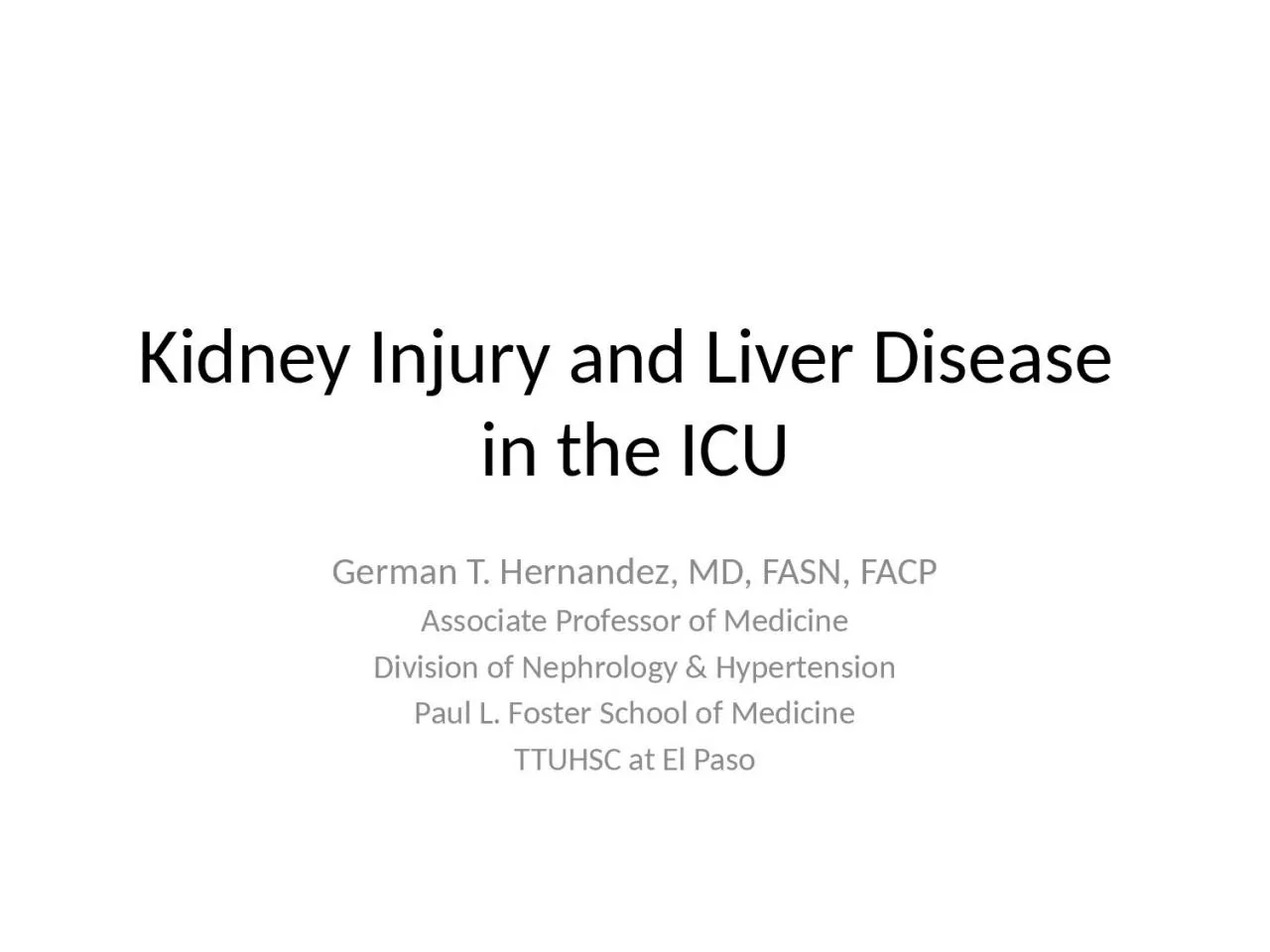

in the ICU German T Hernandez MD FASN FACP Associate Professor of Medicine Division of Nephrology amp Hypertension Paul L Foster School of Medicine TTUHSC at El Paso Learning Objectives ID: 930164
Download Presentation The PPT/PDF document "Kidney Injury and Liver Disease" is the property of its rightful owner. Permission is granted to download and print the materials on this web site for personal, non-commercial use only, and to display it on your personal computer provided you do not modify the materials and that you retain all copyright notices contained in the materials. By downloading content from our website, you accept the terms of this agreement.
Slide1
Kidney Injury and Liver Disease in the ICU
German T. Hernandez, MD, FASN, FACP
Associate Professor of Medicine
Division of Nephrology & Hypertension
Paul L. Foster School of Medicine
TTUHSC at El Paso
Slide2Learning Objectives
1. Define the
Hepatorenal
Syndrome
2. Discuss the use of emerging medical therapies in
Hepatorenal
Syndrome
2. Recognize the abdominal compartment syndrome as cause of acute kidney injury
Slide3Acute Kidney Injury
Many Definitions:
Increase in serum creatinine ≥1.5x baseline within 7 days (RIFLE)
or
Increase in serum creatinine by 0.3 mg/
dL or ≥1.5x baseline with 48 hrs (AKIN)
Crit
Care 2004; 8:B204
Crit
Care 2001; 11:R31
Slide4Acute Kidney Injury: Classification
Prerenal
AKI
Intrinsic AKI
Acute Tubular Necrosis (ATN)
Interstitial NephritisGlomerulonephritisVascular syndromesIntra-tubular obstruction
(crystals,
myeloma casts)
Post-renal AKI
Slide5Acute Kidney Injury in Liver Disease
Caveat:
Renal dysfunction in liver disease may go unrecognized
Decreased creatinine and urea production
A normal serum creatinine (1.0-1.3) may represent a low glomerular filtration rate (
eGFR
)
Am J Med 1987; 82:945
Slide6Prerenal AKIATN
Hepatorenal
Syndrome
Interstitial Nephritis
Glomerular Diseases
MPGN (Hep C)IgA nephritisMembranous nephropathy (
Hep
B)
Cryoglobulinemia
(
Hep
C)
Acute Kidney Injury in Liver Disease
Slide7Hepatorenal Syndrome
F
unctional renal failure caused by
intrarenal
vasoconstriction in patients with ESLD
Splanchnic vasodilatationRelatively low cardiac output
Effective circulatory
hypovolemia
Gut 2007; 56:1310-1318
Slide8HRS typically presents with:Oliguria
Benign urine sediment
Very low urine Na excretion
Progressive rise in serum creatinine
(may have periods of stabilization)
Hepatorenal
Syndrome
Gut 2007; 56:1310-1318
Slide9Pathophysiology
Slide10HRS Diagnostic Criteria
HRS is a diagnosis of exclusion
Cirrhosis with ascites
Serum Creatinine > 1.5 mg/
dL
No improvement in SCr (<1.5 mg/dL
) after at least 2 days of diuretic withdrawal and IV albumin (1g/kg/day, max 100g/day)
Absence of shock
No intrinsic renal disease: proteinuria >500mg/day, >50 RBC/HPF, or abnormal renal US
Gut 2007; 56:1310-1318
Slide11Hepatorenal Syndrome
Type-1 HRS
Rapid progression of kidney injury with a rise in
SCr
>2x baseline in less than 2 weeks
Can develop spontaneously, but commonly follows:SBP or other infection
GI bleeding
Gut 2007; 56:1310-1318
Slide12Hepatorenal Syndrome
Type-2 HRS
Associated with diuretic-resistant ascites and less renal insufficiency than type-1 HRS
Gut 2007; 56:1310-1318
Slide13Outcomes in HRS
Gut 2007; 56:1310-1318
Slide14HRS: Treatment
Liver transplantation for both type 1 and 2 HRS
Vasoconstrictors for type 1 HRS
Terlipressin
Norepinephrine
Midodrine/octreotide
TIPS
Slide15HRS Type 1: Terlipressin & Albumin
Terlipressin
: vasopressin analog, reduces splanchnic vasodilatation
Dosing: 1-2 mg IV every 4hrs
Given with IV Albumin 1g/kg, then 20-40g/day
Significant improvement in renal function
Not available in the USA
No difference in survival at 3 months vs. albumin alone
Survival benefit for renal responders
Gastroenterology 2008; 134:1352-9
Slide16Renal Response: Terlipression+Albumin
vs
Albumin alone
Gastroenterology 2008; 134:1352-9
Slide17HRS-1: Norepinephrine
Uncontrolled pilot study, n=12
Norepinephrine 0.5-3mg/
hr
with IV albumin and furosemide
Hepatology
2002; 36:374-380
Slide18HRS-1: Midodrine & Octreotide
Midodrine
- selective alpha-1 adrenergic agonist
Causes increase in peripheral vascular resistance
Octreotide
-analogue of
somatostatin
Inhibits endogenous vasodilator release, thereby reducing splanchnic vasodilatation
The combination is thought to improve renal and systemic hemodynamics
Slide19HRS-1: Midodrine & Octreotide
Group A: 8 subjects treated with
Dopamine 2-4mcg/kg/min
Group B: 5 subjects treated with
Midodrine
7.5-12.g mg
po
TID
Octreotide
100-200 mcg
subq
TID
Both meds titrated to an increase in MAP of ≥ 15 mmHg
Both groups also received IV Albumin
Hepatology
1999; 29:1690-7
Slide20Dopamine vs. Midodrine+Octreotide
Hepatology
1999; 29:1690-7
Slide21Dopamine vs. Midodrine+Octreotide:
Survival
Hepatology
1999; 29:1690-7
Slide22Abdominal Compartment Syndrome
Intra-abdominal hypertension
Intra-abdominal pressure ≥ 12 mmHg; (normal 5-7 mmHg) or
Abdominal perfusion pressure <60 mmHg
APP=MAP-IAP
Abdominal compartment syndromeIAP ≥ 20 mmHg and new organ dysfunction
Intensive Care Med 2006; 32:1722
Slide23Slide24Slide25Abdominal Compartment Syndrome
Systemic effects
Impaired cardiac function (from compression due to elevation of diaphragm); reduced venous return
Increased intra-thoracic pressures, risk of barotrauma, etc.
Decreased splanchnic perfusion
Decreased hepatic ability to metabolize lactic acid
Increase in ICP
Intensive Care Med 2006; 32:1722
Slide26Abdominal Compartment Syndrome
Renal effects
Acute kidney injury due to:
Renal vein compression with higher venous resistance and impaired venous drainage
Renal artery vasoconstriction via overactive sympathetic drive and renin-angiotensin axis
Drop in GFR
Drop in urine output: Oliguria with IAP 15 mmHg, anuria with IAP 30 mmHg
Decreased urine sodium and chloride
Trauma 2000; 48:874
Slide27Abdominal Compartment Syndrome
Clinical settings in which to keep ACS in mind
Trauma patients following aggressive volume resuscitation
Burn patients >30% BSA
Post liver transplant
Massive ascites, bowel distention, abdominal
surgery,
intraperitoneal
bleeding
Ruptured AAA, pelvic
fx
with bleeding, pancreatitis
Crit
Care Med 2005; 33:315
Crit
Care Med 2004; 30:822
Slide28Abdominal Compartment Syndrome
Diagnosis
First of all think of the diagnosis
Measure IAP
Treatment
Abdominal Decompression
Renal dysfunction is generally reversible if decompression is done in a timely manner
Trauma 2000; 48:874
Arch Intern Med 1985; 145:553
Slide29The End
Thank you for
your attention